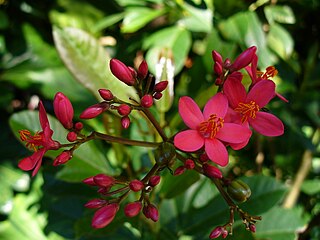
Jatropha is a genus of flowering plants in the spurge family, Euphorbiaceae. The name is derived from the Greek words ἰατρός (iatros), meaning "physician", and τροφή (trophe), meaning "nutrition", hence the common name physic nut. Another common name is nettlespurge. It contains approximately 170 species of succulent plants, shrubs and trees. Most of these are native to the Americas, with 66 species found in the Old World. Plants produce separate male and female flowers. As with many members of the family Euphorbiaceae, Jatropha contains compounds that are highly toxic. Jatropha species have traditionally been used in basketmaking, tanning and dye production. In the 2000s, one species, Jatropha curcas, generated interest as an oil crop for biodiesel production and also medicinal importance when used as lamp oil; native Mexicans in the Veracruz area developed by selective breeding a Jatropha curcas variant lacking the toxic compounds, yielding a better income when used as source for biodiesel, because of its edible byproduct. Toxicity may return if edible Jatropha is pollinated by toxic types.

The flea beetle is a small, jumping beetle of the leaf beetle family (Chrysomelidae), that makes up the tribe Alticini which is part of the subfamily Galerucinae. Historically the flea beetles were classified as their own subfamily.
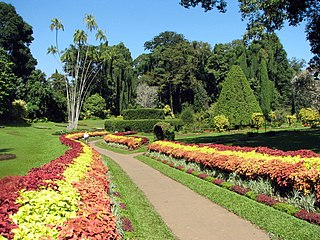
Royal Botanic Gardens, Peradeniya are about 5.5 km to the west of the city of Kandy in the Central Province of Sri Lanka. In 2016, the garden was visited by 1.2 million locals and 400,000 foreign visitors. It is near the Mahaweli River. It is renowned for its collection of orchids. The garden includes more than 4000 species of plants, including orchids, spices, medicinal plants and palm trees. Attached to it is the "National Herbarium of Sri Lanka". The total area of the botanical garden is 147 acres (0.59 km2), at 460 meters above sea level, and with a 200-day annual rainfall. It is managed by the Division of National Botanic Gardens of the Department of national botanic gardens.

Jatropha podagrica is a succulent plant in the family Euphorbiaceae. It is native to the tropical Americas but is grown as an ornamental plant in many parts of the world due to its unusual appearance. Common names include Gout Plant, Gout Stalk, Guatemalan Rhubarb, Coral Plant, Buddha Belly Plant, Purging-Nut, Physic Nut, Goutystalk Nettlespurge, Australian Bottle Plant, and Tartogo.

Morellia is a very large genus from the fly family Muscidae. Morellia are plumpish black flies, largely lacking eye hairs - sparse at most. they have a white dusting on the parafacialia and the scutum has 4 distinct longitudinal stripes.
The Barbados rail is a fossil rail species endemic to Barbados with an undetermined taxonomic status. It was formerly described by Pierce Brodkorb in 1965 as Fulica podagrica. However, this classification has been questioned by Storrs Olson when he described Brodkorb's material anew in 1974. It is only known by Brodkorb's holotype which consists of a humerus and several leg elements including femur, tibiotarsus and tarsometatarsus fragments. The humerus may not be specifically distinct from those of the American coot but most of the femur, tibiotarsus and tarsometarsus fragments are from a yet undescribed larger rail of an undetermined genus not related to Fulica. Olson further assumed that Brodkorb's material might be a composite of several rail species. The bone fragments were unearthed in Late Pleistocene deposits in Saint Philip Parish and Ragged Point on Barbados.

Morellia podagrica is a fly from the family Muscidae.
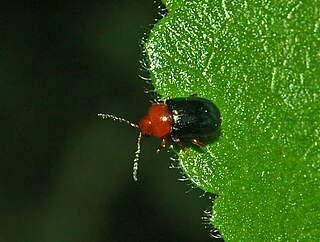
Podagrica malvae is a species of skeletonising leaf beetles belonging to the family Chrysomelidae, subfamily Galerucinae.

Oreodera is a genus of beetles in the family Cerambycidae, containing the following species:
Oreodera podagrica is a species of beetle in the family Cerambycidae. It was described by Neouze and Tavakilian in 2010.
Chaetomium undulatulum is a fungus species in the Chaetomium genus, first isolated from Iran. It shares features such as peridium structure, ascospore morphology and germ pore position with its cogenerates. It is closely related to C. globosum.
Chaetomium rectangulare is a fungus species in the Chaetomium genus, first isolated from Iran. It shares features such as peridium structure, ascospore morphology and germ pore position with its cogenerates. It is closely related to C. elatum.
Chaetomium interruptum is a fungus species in the Chaetomium genus, first isolated from Iran. It shares features such as peridium structure, ascospore morphology and germ pore position with its cogenerates. It is closely related to C. megalocarpum.
Chaetomium grande is a fungus species in the Chaetomium genus, first isolated from Iran. It shares features such as peridium structure, ascospore morphology and germ pore position with its cogenerates. It is closely related to C. megalocarpum.
Chaetomium iranianum is a fungus species in the Chaetomium genus, first isolated from Iran. It shares features such as peridium structure, ascospore morphology and germ pore position with its cogenerates. This species in particular can be characterized by spirally coiled ascomatal hairs and fusiform ascospores.
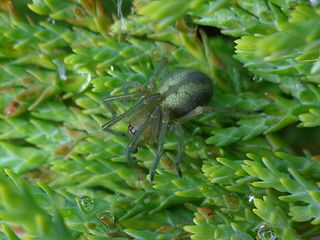
Cheiracanthium erraticum, the two-clawed hunting spider, is a species of Palearctic spider of the family Cheiracanthiidae.
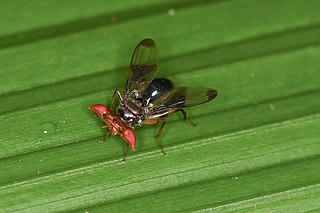
Richardia is a genus of flies in the family Richardiidae. It was first described by French entomologist Jean-Baptiste Robineau-Desvoid in 1830. It occurs from Mexico to Central and South America.
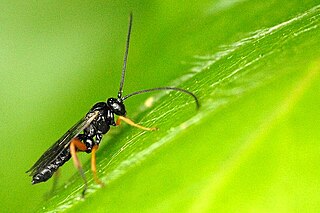
Schizopyga is a genus of ichneumon wasps in the family Ichneumonidae. There are about 10 described species in Schizopyga.

Neoascia obliqua is a Palearctic species of hoverfly.












